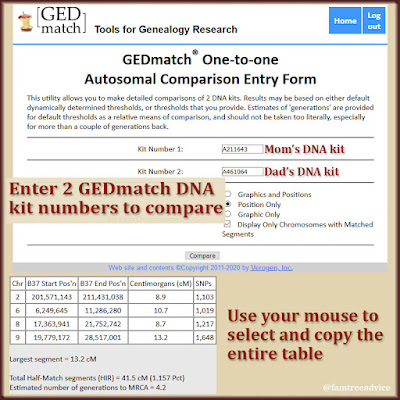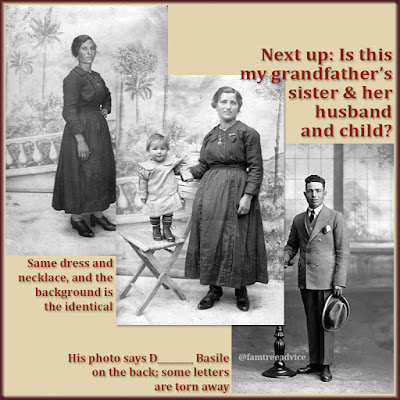The GEDmatch website has lots of intriguing tools for you to try. First you need to upload the raw DNA file you downloaded from your DNA testing site.
If your parents have the same general background, try the "Are your parents related?" link. It examines your DNA for segments you inherited from both your parents. On my chromosome 2 there's a 7.6 centiMorgan (cM) segment that seems to come from both my parents.
That's definitely my dumbed-down version of the calculation. But it says, "This analysis indicates that your parents may be distantly related."
 |
| GEDmatch showed my parents may be related. But how? |
I discovered this quite a while ago, and I've since had both my parents submit a DNA test. Here and there I've been seeing DNA matches that they share. The most shocking one is my 1st cousin. He's my mother's sister's son, yet he's a DNA match to my dad!
Because of all this, I've been hoping to find an actual connection between my parents. Either a shared ancestor or an intermingled bloodline. Both their families came from a small area in Italy. All their ancestral towns neighbored one another. It's possible their entire relationship may be nothing but endogamy. That's what you get when a small population keeps intermarrying for hundreds of years.
But I keep searching for the answer.
There's another GEDmatch tool called the "One-to-one Autosomal DNA Comparison." I ran it to compare each of my parents' DNA kits to one another. The result was a table showing the 4 chromosomes where they shared 7 or more cMs.
The table doesn't make it terribly clear how many cMs my parents share, but there's a 2nd tool that's more helpful. I launched the DNA Painter website and logged in to my account. In the Tools menu I chose the Individual Match Filter at the bottom. Here you can paste in that results chart from GEDmatch to see the number of cMs these 2 people share.
The result was a very fast and clear 42 shared cMs. I can take that number and consult a consanguinity chart. That's a chart that tells you possible relationships based on the number of shared cMs.
 |
| After GEDmatch, you can use DNA Painter and a consanguinity chart for more analysis. |
You may not find the exact number of cMs you're looking for on the chart. The closest numbers I see to 42 are 26.56 and 53.13. My target of 42 is a bit closer to the higher number. So I'll focus on 53.13 in the chart.
Here's what I see as possible relationships with 53.13 shared cMs.
Option 1: 1st cousins 4 times removed
My parents are the same generation and the same age. That makes it unlikely that they could have more than 1 or 2 "removals" in their relationship. Their parents and grandparents were all about the same age. I'm going to rule out the 1st cousins 4 times removed option.
Option 2: 2nd cousins 2 times removed
For this to be true, their shared ancestors would be 1st great grandparents of one and 3rd great grandparents of the other. This 2-generation span might work if you had very young parents in one branch and very old parents in another.
For instance, my grandfather was 20 years older than his sister. So his sister's children are around my age even though they're my dad's 1st cousins. But spanning 2 generations while being the same age also feels like too much of a stretch. Not impossible, but pretty unlikely.
Option 3: 3rd cousins
If my parents were 3rd cousins, they'd share a pair of 2nd great grandparents. I know that isn't true because I've identified all their 2nd great grandparents. But remember, they share a bit less than 53.13 cMs, so they may have something less than a 3rd cousin relationship. What if there's a marriage between a pair of their 2nd great grandparents' siblings?
That sounds like a good option. It's something that is possible since their hometowns were close to one another. And it isn't something I've been able to rule out.
Now I need a research plan.
- I can continue harvesting facts from my downloaded collection of Italian vital records.
- I can focus on finding the marriages of as many of those siblings as possible. This generation was born and married before the Italian government began keeping records. But if I can find their death records, I'll know who they married.
- I can start by finding dead ends on my family tree. For example, one set of mom's 2nd great grandparents is Antonio Bozza and Angela Cece. I know Angela's ancestors, but I found only 1 of her siblings. And all I know about Antonio is his father's name. If I work to identify more of their family members, maybe I'll find someone who's spouse is from one of dad's towns.
- My grandparent chart lists all their 2nd great grandparents (my 3rd great grandparents). I'll review these 16 couples to see which of their families need more sibling research.
- I'll continue investigating the couples, ruling out some, and narrowing down the list.
 |
| I'll use my grandparent chart and narrow down my search among their 2nd great grandparents' siblings. |
I've been jumping around in my research a lot lately. It's all been fun. I spent Saturday adding 3 generations to my 2nd cousin once removed's tree at his request.
But I would like to exhaust all possibilities on my parents' DNA relationship.
Even if your parents aren't related, be sure to explore the tools on GEDmatch—and take advantage of DNA Painter—to see what else you can learn about your ancestry.












